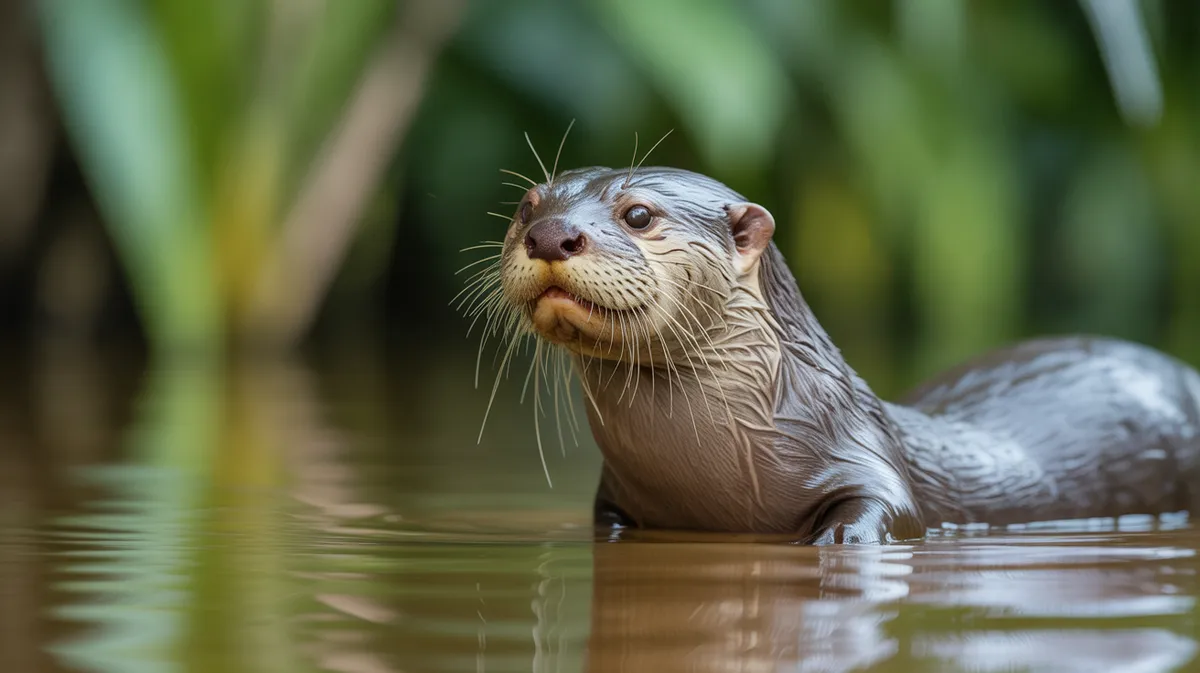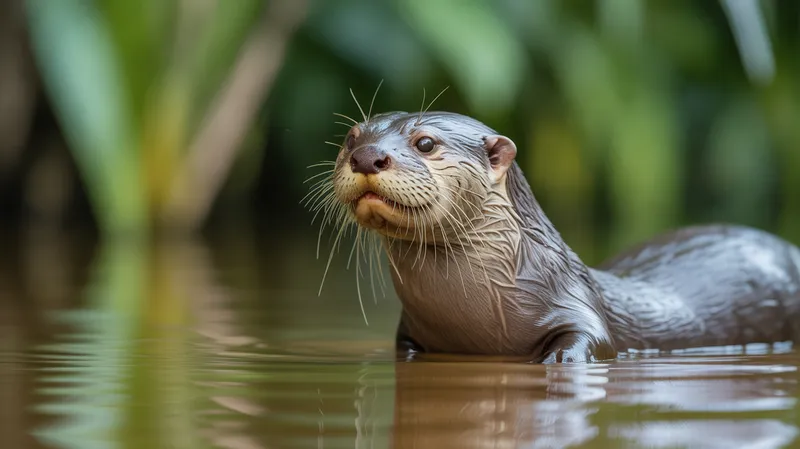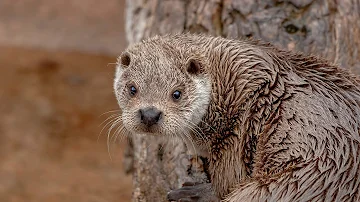
Giant Otter
Pteronura brasiliensis

Meet the Giant Otter
The Giant Otter is the largest member of the otter family, reaching lengths of up to 1.7 meters (5.6 feet) and noted for its sleek, chocolate-brown fur and conspicuous throat markings. Native to the rivers and lakes of South America's Amazon, Orinoco, and La Plata river systems, it is a highly social species, living in tight-knit family groups. Giant otters are aquatic carnivores, known for their agility, powerful tails, and webbed feet, which aid in catching fish and crustaceans. Vocal and playful, they communicate with a variety of sounds and are recognized as one of the most vocal otter species.
Classification
Mammal
Habitat
Freshwater rivers, lakes, and wetlands in tropical rainforests
Diet
Carnivore
Lifespan
10-12 years in the wild
Conservation
Endangered
Weight
22–34 kg (49–75 lbs)
📖Fascinating Facts
Largest Otter Species
The giant otter is the largest of all otter species, with adults reaching up to 1.7 meters in length including the tail.
Vocal Communicators
Giant otters use an array of vocalizations, including barks, whistles, and screams, to communicate within their groups.
Family Bonding
They live in family groups of up to 10 individuals, cooperating to defend territory and care for the young.
📋Detailed Description
The giant otter (Pteronura brasiliensis) is the largest member of the Mustelidae family, with adults typically measuring 1.5 to 1.8 meters in length and weighing between 22 and 34 kilograms. Its streamlined body, muscular tail, and fully webbed feet are highly adapted for an aquatic lifestyle, enabling remarkable agility and speed in water. The dense, velvety fur is chocolate-brown with distinctive pale markings on the throat and under the chin, which are unique to each individual and used for identification within groups. Giant otters possess a broad, flattened head, small rounded ears, and large, sensitive whiskers (vibrissae) that help detect prey in murky waters. Socially, they are among the most cohesive of all otter species, living in extended family groups of up to 10 individuals, typically led by a monogamous breeding pair and their offspring. These groups maintain and defend large, linear territories along riverbanks, marked with scent from specialized anal glands. Communication is complex, with at least 22 distinct vocalizations documented, including barks, whistles, and screams that convey alarm, reassurance, or coordinate group activities. Diurnal by nature, giant otters are active during daylight, spending much of their time hunting, grooming, and playing. Their diet is primarily piscivorous, but they also consume crustaceans, small reptiles, and occasionally small mammals. The species is highly sensitive to environmental disturbance, making it an important bioindicator of healthy freshwater ecosystems.
💡 Did you know?
Giant otters are the most social of all otter species and often hunt cooperatively in groups to catch larger prey.
🔬Research & Sources
Wikipedia Summary
The giant otter or giant river otter is a South American carnivorous mammal. It is the longest member of the weasel family, Mustelidae, a globally successful group of predators, reaching up to 1.8 m. Atypical of mustelids, the giant otter is a social species, with family groups typically supporting three to eight members. The groups are centered on a dominant breeding pair and are extremely cohesive and cooperative. Although generally peaceful, the species is territorial, and aggression has been observed between groups. The giant otter is diurnal, being active exclusively during daylight hours. It is the noisiest otter species, and distinct vocalizations have been documented that indicate alarm, aggression, and reassurance.
Last Modified: 6/5/2025
🎭Behavior & Social Structure
Giant otters are highly social and exhibit cooperative behaviors rarely seen in other mustelids. Family groups engage in coordinated hunting, often herding fish into shallow waters where they can be more easily captured. Individuals use their acute vision and sensitive whiskers to locate prey, typically catching fish with rapid, agile movements. After successful hunts, food is often shared among group members, especially with juveniles. Social grooming is frequent and serves to reinforce bonds and maintain fur condition. The species is territorial, with groups vigorously defending their home ranges through vocal displays, scent marking, and, if necessary, physical confrontations with neighboring otter groups. Daily routines include periods of foraging interspersed with rest, grooming, and play, the latter being particularly prominent among juveniles but also observed in adults. Play behaviors include chasing, wrestling, and synchronized swimming. Giant otters construct dens (holts) in riverbanks, with multiple entrances and chambers, which serve as shelter and breeding sites.
👶Reproduction & Life Cycle
Giant otters are monogamous, with pairs forming long-term bonds that persist across multiple breeding seasons. Breeding can occur year-round but tends to peak during the dry season (typically July to October in the Amazon). After a gestation period of approximately 65–70 days, females give birth to litters of 1–6 pups (average 2–3) in underground dens. Pups are born blind and helpless, weighing around 200 grams, and remain in the den for the first four to five weeks. Both parents, as well as older siblings, participate in rearing the young, providing food, protection, and socialization. Pups are introduced to water at about 8–10 weeks of age and begin to accompany adults on hunting excursions by three to four months. Sexual maturity is reached at around two years, but dispersal from the natal group may be delayed until suitable territories become available.
🛡️Adaptations & Survival
The giant otter exhibits several specialized adaptations for aquatic life. Its dense, water-repellent fur insulates against heat loss and prevents skin from becoming waterlogged. The long, muscular tail acts as a powerful rudder, while webbed feet enhance swimming efficiency. Nostrils and ears can close underwater to prevent water ingress. The species has excellent vision both above and below water, and its vibrissae are highly sensitive to vibrations, aiding in the detection of prey in turbid conditions. Social adaptations include complex vocal communication and cooperative hunting strategies, which increase foraging success and group cohesion. Territorial scent marking and visual throat patterns facilitate individual recognition and group identity.
📚Research Sources
🎨Cultural Significance
In indigenous Amazonian cultures, the giant otter is often regarded with a mix of reverence and fear, sometimes viewed as a guardian of rivers or as a symbol of strength and family unity. Folklore in some regions attributes supernatural qualities to the species, associating it with water spirits or river monsters. In modern times, the giant otter has become a flagship species for conservation efforts in South America, symbolizing the need to protect freshwater ecosystems. Ecotourism centered on giant otter observation has economic importance in some regions, promoting habitat preservation and environmental awareness.
🔬Recent Research & Discoveries
Recent research has focused on the giant otter's role as an apex predator and its importance in maintaining the ecological balance of freshwater systems. Studies using camera traps, GPS telemetry, and genetic analysis have improved understanding of population structure, dispersal, and territory use. Ongoing research is investigating the impacts of mercury contamination on otter health and reproduction, as well as the effects of habitat fragmentation on genetic diversity. Conservation programs are increasingly involving local communities in monitoring and habitat restoration. Vocalization studies continue to reveal the complexity of giant otter communication and its role in social organization.
🎥Wildlife Videos

Why The Fearless Giant Otters Are Called River Wolves | Our World
TALES FROM THE WILD takes some of the most spectacular wildlife moments ever caught on film from the Survival Archive and ...
Our World

Amazing Otter Moments | BBC Earth
Otters are a member of the weasel family and can be found on every continent except Australia and Antarctica. They may be cute ...
BBC Earth

Giant Otters: The Story of Peru's River Wolves | Our World
Explore the captivating world of the giant otters of Peru's Amazon in this wildlife documentary. Known as "river wolves," these ...
Our World

The Enchanting Life Of The Giant Otter | Our World
The Giant Otter is the largest of its kind on earth. As playful and enchanting as their much smaller cousins, these rare and beautiful ...
Our World

Giant Otters (1990)
A trip down the Amazon to study giant otters, which are threatened by rain-forest destruction, polluted waters and hunting.
ThisOldVideo2

Watch giant river otters learn to fish | BBC Global
It takes three years for an otter cub to master the complexities of fishing. Watch as a bevy of otters learn how to fish from their father ...
BBC Global
🌍Habitat Information
The Giant Otter typically inhabits Freshwater rivers, lakes, and wetlands in tropical rainforests environments. Giant Otters have adapted to their environments with specialized features and behaviors.
Primary Habitat:
Freshwater rivers, lakes, and wetlands in tropical rainforests
More detailed habitat information will be available soon.
🛡️Conservation Status
The Giant Otter is currently classified as Endangered. Conservation efforts are crucial for preserving this species for future generations.
Common Threats:
- 🏠Habitat loss and fragmentation
- 🌡️Climate change impacts
- 🎯Hunting and poaching
- 🏭Human-wildlife conflict
⚠️Threats & Conservation Challenges
The giant otter faces numerous threats, primarily from habitat destruction due to deforestation, gold mining, and agricultural expansion, which degrade and fragment critical wetland habitats. Pollution, especially mercury contamination from illegal gold mining, poses significant health risks. Overfishing and competition with humans for fish stocks reduce prey availability. The species was historically hunted for its valuable pelt, leading to dramatic population declines in the 20th century; while commercial hunting has largely ceased, illegal poaching still occurs in some areas. Human disturbance, including boat traffic and ecotourism, can disrupt breeding and foraging. Current population estimates suggest fewer than 5,000 mature individuals remain, with populations fragmented and declining in many parts of their range. Conservation challenges include enforcing protected areas, restoring habitat connectivity, and mitigating human-wildlife conflict.
🔬Scientific Classification
Scientific Name
Pteronura brasiliensis
Classification Hierarchy
🔍 About Taxonomic Classification
Taxonomic classification is a hierarchical system used by scientists to classify and organize living organisms based on shared characteristics and evolutionary relationships.
The system moves from broad categories (Kingdom) to increasingly specific ones, with each animal's scientific name typically consisting of its Genus and species.
📝Community Notes
Share your observations and insights about the Giant Otter with our community of wildlife enthusiasts.
Join Our Community
Sign in to share your observations and connect with fellow wildlife enthusiasts.
Sign In to ContributeNo community notes yet
Be the first to share your observations about the Giant Otter!
Explore Giant Otter
Select a tab above to learn more about this amazing animal.
📸Photo Gallery
No photos available for this animal yet.
🌟Discover More Wildlife
Continue your journey of discovery with more fascinating animals from our database
